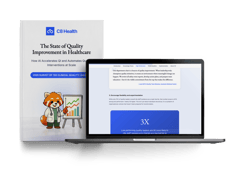
3 Virtual Onboarding Challenges and Ways to Overcome Them
Healthcare is undergoing a digital transformation, with virtual consultations and remote work becoming increasingly common. While this offers flexibility and convenience, it also comes with an issue: onboarding new staff.
The future success of a hire largely depends on how quickly they integrate into the work environment. For example, a nurse would ideally surround herself with experienced colleagues. She would learn by observing them and asking questions on the fly.
You can't get that kind of experience over the screen. This is just one of the many challenges you may face if you decide to train staff this way. That's why we've prepared an in-depth guide on how to overcome them.
What is Virtual Onboarding in Healthcare?
Virtual onboarding is the process of integrating new healthcare professionals into an organization using digital tools. This approach replaces classroom sessions and hospital tours and is especially relevant with the rise of telehealth and geographically dispersed teams.
Core elements include:
- Live Video Conferencing: Organizations can offer lessons where department representatives cover areas like introductions, policies, and Q&A.
- Pre-Recorded Content: Hires may get standardized information like safety protocols and facility overviews through pre-recorded videos in a knowledge base. This is ideal for those who learn best at their own pace.
- Interactive Learning: Hospitals can create modules with quizzes, simulations, or gamification to make focused learning possible. It can be specific to each user's area of expertise, equipping them with the necessary skills to excel in their roles.
- Resource Library: A central online platform that houses all onboarding materials, departmental guidelines, FAQs, and even ongoing educational content for easy access.
- Mentorship Programs: Experienced employees can guide and support recently hired workers via conference calls, instant messaging, or forums.
By participating virtually, new staff learn self-sufficiency and how to use technology for communication and collaboration-essential skills in today's healthcare landscape.
1. Lack of Communication
Virtual environments hinder the development of rapport and collaborative spirit. New hires may struggle to build connections with colleagues, leading to feelings of isolation and impacting overall integration.
How to Overcome This Onboarding Challenge
To bridge the gap, you can use activities like online quizzes or polls to break the ice. Traditional team-building exercises can also work in a digital setting. For example, you can use interactive online games or competitive collaborative projects to help people bond.
Assign a single point of contact, especially for IT issues. This streamlines problem-solving and avoids the frustration of getting bounced around different departments.
Onboarding surveys are also powerful tools for showing your staff that their voices matter. When recruits see that you need their opinions, they feel like an essential part of the team. This boosts engagement and fosters a positive training experience.
Plus, gathering feedback lets you identify and address issues early on. You can prevent minor problems from snowballing and ensure a smoother experience for everyone.
Note: Based on feedback, you can identify knowledge gaps and schedule dedicated Q&A sessions with experts to address them directly. This shows you're listening and taking action.
2. Fragmented Learning
Virtual onboarding often involves segmented modules and interactions with various personnel. This can create a disjointed learning experience, making information retention difficult.
How to Overcome This Onboarding Challenge
You can move beyond static PDFs by offering interactive lessons, case studies, and quizzes to test the recruits' understanding actively. Employees may also like gamified training with points, badges, and leaderboards.
Additionally, you can build a knowledge base containing answers to FAQs, troubleshooting guides, and other helpful materials. C8 Health can help you centralize all your institution's clinical guidelines and best practices, making them accessible on mobile devices.
Our latest white paper can help healthcare organizations integrate and improve their knowledge management practices.
3. Environmental Disconnect
Remote onboarding lacks immersion into the physical healthcare setting. New employees miss out on experiencing the sights, sounds, and workflows firsthand, potentially limiting their understanding of the work environment.
How to Overcome This Onboarding Challenge
You can go beyond images with immersive 360-degree video tours or interactive facility maps. This adds a sense of realism and familiarity, helping the employee get acquainted.
Plus, try scheduling virtual "meet and greets" with department heads or key staff members. This empowers your workforce to put faces to names and ask questions more informally.
Evaluating Your Virtual Onboarding Program
A crucial aspect to consider with virtual onboarding is the reduced ability to monitor learners in real-time. Unlike in-person sessions, where instructors can gauge engagement and adjust pacing based on body language or facial expressions, digital environments require a more strategic approach.
When designing programs, actively participating as a new hire can identify user-facing issues. But, this method lacks objectivity and struggles to scale with increased volume of hires.
Data-driven metrics provide a more comprehensive and quantifiable solution to overcoming onboarding challenges. By incorporating surveys designed to measure specific benchmarks, healthcare providers gain valuable insights and tailor effective learning plans.
| Key Metrics | What They Measure | Why They Matter |
|---|---|---|
| New Hire Engagement | Completion rates for virtual training modules, online forum participation, and live video session attendance. | Suggests participants actively learn and absorb information. |
| Knowledge Retention | Pre- and post-onboarding assessments to gauge knowledge acquisition in core areas like policies, procedures, and software. | Shows if onboarding effectively equips new staff with the knowledge needed to perform their job duties. |
| Time to Proficiency | Strong knowledge retention ensures recruits have the necessary skills and information to perform their jobs effectively. | Indicates if onboarding efficiently prepares them to become productive team members. |
| Employee Satisfaction | Post-onboarding surveys gauge new staff's satisfaction with the process. | Helps identify areas for improvement and ensures a positive new hire experience. |
| Retention Rate | Data analysis calculates the number of employees you keep over a specified period, such as three, six, or twelve months. | Suggest a successful onboarding program that promotes a positive work environment and reduces turnover costs. |
Setting Up for Success
Investing in a well-optimized virtual onboarding program is an investment in your healthcare institution's future. By prioritizing clear communication and providing readily available resources, hospitals can create an environment that empowers employees to thrive and overcome challenges.
C8 Health acts as a comprehensive learning aid for hires during training. It encourages them to take charge of their education, access critical knowledge quickly, and transition smoothly into their new roles with greater confidence and competence.





